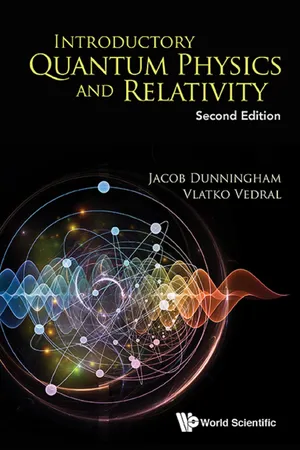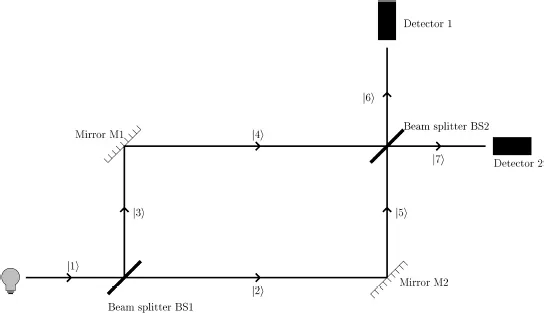![]()
Chapter 1
Introduction
Modern physics is founded on two very important discoveries of the last century: quantum physics and relativity. Both of these were developed to deal with major failings of Newtonian physics. One was in the domain of small particles, such as atoms, where Newtonian physics gives completely wrong predictions. The other failure was in the domain of large velocities, where again Newtonian physics cannot explain some very basic experimental results. The first part of this book will be dedicated to quantum physics; the latter part will introduce the theory of relativity. Both theories have radically changed our everyday intuitions of what objects ought to be and how they ought to behave. It has taken physicists a long time and a great deal of effort to come to terms with some of their implications. A few of these are still viewed as controversial and difficult to grasp even though there is overwhelming experimental support in their favour.
What this book aims to convey are the most recent and accurate descriptions of nature. In some sense they are very different to anything we have seen before. In another very important way, they are not. Quantum physics and relativity are a natural outgrowth of humanity’s two-and-a-half-millennia-old quest to understand the universe in a particular rational way. The principles that were laid down by the Ancient Greek philosopher Socrates, the ‘grandfather’ of Western philosophy, were:
(i)Knowledge can be pursued and is worth pursuing;
(ii)The search for knowledge is a cooperative enterprise;
(iii)A question is a form of education that draws out what is in a person rather than imposing on him a view from outside;
(iv)Knowledge must be pursued with a ruthless intellectual honesty.
You will hopefully begin to appreciate these principles more and more as you progress with your studies. Physics, perhaps more than any other human activity, embodies this age-old quest for knowledge. This was, in fact, first fully appreciated by the philosopher Karl Popper. We discuss his ideas a bit here, because they provide a perfect setting for introducing two such revolutionary theories as quantum physics and relativity.
Popper realised that physics (and science in general) makes progress via the method of conjectures and refutations. What this means is that scientists make a conjecture about how something works and then test it in practice to see if their hypothesis is confirmed. If not, the conjecture is discarded and another one tested. It is clear that this will have to be a cooperative enterprise as well as an open-minded and honest quest. No matter how fond scientists become of their pet theories, they still have to abandon them when a contradiction is found with experiments. In this way there is a curious philosophy behind any science. No scientific knowledge can ever be proven right. Any theory, if not falsified by an experiment today, just lives to die another day. Another philosopher, David Hume, captured this with a now-famous statement (which we are slightly paraphrasing here): “no number of sightings of white swans can ever prove the hypothesis that all swans are white, but observing a single black swan can and does completely invalidate it”. And so it is with Newtonian classical mechanics. In this case, there were two black swans of classical physics. One was the theory of relativity and the other, quantum physics. By the end of this book (and this is really our main motivation) you will appreciate how quantum physics and relativity together form an important part of our cultural heritage.
We start with quantum theory. Objects in the everyday world are considered to be positioned somewhere, to exist at some instant of time and to be traveling at a certain velocity. Newtonian physics stipulates that as soon as we know the position and velocity of an object of a given mass, as well as all the forces that act upon it, then Newton’s equations of motion fully determine all the future behaviour of that object. For example, if you know the position and velocity of the Sun, the Earth and the Moon at the present time, you can determine exactly when the next eclipse of the Sun by the Moon will take place on Earth. It is truly remarkable that so little seems to be needed in order to deduce so much. But the compression of all facts into a few simple laws of nature is precisely the point of physics.
Everyday objects, either in addition to or because of the laws of physics, also obey the laws of Boolean logic. It is not clear if logic is something different to physics (probably not!), but let us talk about it as such for the moment. The key law of Boolean logic is the one of excluded middle. An object, such as a chair, is either positioned “here” or “not here”, but no other possibility can be allowed. If something exists, but it is not here, then it must be elsewhere. And things either exist or do not, no third option is logically possible, according to Boole.
Another important law of Boolean logic states that if we think of a proposition (“That chair is positioned in this room”) and then we think of another proposition (“The chair has zero velocity”), then the order of making these propositions can be reversed and we will still end up with the same overall proposition (“That chair is positioned in this room and it has zero velocity” is simply the same as “That chair has zero velocity and it is positioned in this room”). This law is called the law of commutativity of propositions. You can easily come up with your own propositions and confirm that you can commute them without any change to their meaning.
This all seems fairly reasonable and straightforward. Yet, astonishingly, the world of microscopic objects does not obey Boolean logic — we know this experimentally with a huge degree of certainty. Objects, such as electrons, atoms or photons (particles of light) can, in some sense, exist in many positions (or have many velocities) all at the same time. Furthermore, establishing that “an electron is here now and then that it has some velocity subsequently” is not the same at all as reversing these statements and saying that “an electron has some velocity now and is then located here.” In quantum logic, both the law of the excluded middle and the commutativity of propositions are simply violated. How can this possibly be, when these two laws of logic seem extremely fundamental, so fundamental to be beyond any reasonable doubt? We will now present an experiment that illustrates exactly how quantum objects behave differently from classical objects.
Figure 1.1:Mach–Zehnder interferometer. This is one of the most frequently used interferometers in the spectral study of light. In this book we will use it mainly to illustrate the ‘unusual’ behaviour of light in quantum mechanics.
The proof for the existence of particles of light (called photons) has built up over the years since Planck made his ‘quantum hypothesis’, which we will talk about in detail shortly. Now, however, we want to present a simple experiment to illustrate the basic properties of the quantum behaviour of light. This is meant to motivate the rest of the subject without going into too much detail at this stage.
The apparatus in Fig. 1.1 is called a Mach–Zehnder interferometer. It consists of two mirrors and two beam splitters — these are half-silvered mirrors, which pass light with probability 1/2 and reflect it with the same probability. Let us now calculate what happens to a single photon that enters this set up. For this we need to know the action of a beam splitter. It is given by the simple rule
which means that the state a goes into an equal superposition of states b and c. This is just a formal way of saying that a particle that enters at path a, exits as an equal superposition on paths b and c. With this in mind, the Mach–Zehnder interferometer shown in Fig. 1.1 works as follows:
Therefore, if everything is arranged properly, and if both arms of the interferometer have the same length, then the photon will come out and be detected by detector 2 only. This is called interference and is a well-known property of waves — it’s just that in quantum physics every photon behaves in this way.
What would happen if we detected light after the first beam splitter and wanted to know which route it took? Then, half of the photons would be detected in arm 2 and the rest of them would be detected in arm 3. So, it seems that photons randomly choose to move one way or the other at a beam splitter. What’s more, we never detect half the photon in one arm and the other half in the other arm — they are particles and come in chunks. Thus it seems that this is the same as tossing a coin and registering heads or tails. Well, not quite. In fact, not at all, as we shall now see. Suppose that at the first beam splitter the photon goes either upwards or to the right, but it definitely goes either up or right (as our experience seems to suggest). Then, at the second beam splitter the photon would again face the same choice, i.e. it would definitely move either up or right. So, according to this reasoning we should expect detectors 1 and 2 to click with an equal frequency. But this is not what we saw. In reality, only detector 2 clicks. The amplitude and, therefore, the probability for detector 1 to click is zero. This means that the operation of a beam splitter and the behaviour of the photon is not just like coin tossing. The state after the beam splitter is more than just a statistical (random) mixture of the two probabilities. It is, of course, a superposition, and the photon takes both of the possible routes (in spite of being a particle). This is the true meaning behind writing its state as a mathematical sum of two vectors, say |1〉 + |2〉. This is why we use vectors to express states of physical systems.
But we won’t be using this more sophisticated description of physical systems until later in the book. There are several good reasons for delaying it. Firstly, the mathematics used for the full quantum theory is quite advanced. Secondly, there are many important features of quantum systems that can be correctly described using less sophisticated theory. Thirdly, starting with simple things and going towards more complicated stuff has a great pedagogical value. It shows us how our understanding improves and teaches us never to be dogmatic about our understanding since it is very likely that it will be superseded by some better theory. This is probably the most important part of our scientific culture. And finally, if we started with the complicated theory we would miss out on all the beautiful progress that took place at the beginning of the last century, and it was precisely this progress that made it the “Century of Physics.”
We close with a very bizarre consequence of quantum mechanics, called the interaction–free measurement, which has been performed experimentally using lasers and beam splitters. Suppose that in the Mach–Zehnder interferometer we block one of the paths after the first beam splitter, say path 5, by inserting an absorbing material in there as shown in Fig. 1.2.
What happens then? Well if the photon is absorbed, then neither of the two detectors will eventually ‘click’ — that’s fine. However, if the photon takes the other path, then at the second beam splitter it has an equal chance to be reflected and transmitted so that the two detectors click with equal frequencies. In other words, the interference has been destroyed by the presence of the absorber in path 5. But, here is a very weird conclusion: we can detect the presence o...



